W.E. Patt. '08 Braces and Straps
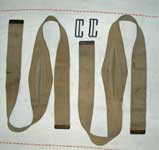
 Braces were introduced as part of Web Equipment, Pattern 1908 in List of Changes entry L. of C. No. 14288, dated 31st January 1908. The first issue Braces were 50-inches long and 2-inches wide, widening to 3-inches in the centers. Each Brace was equipped with a running 2-inch Twigg buckle for attaching the Pack or Haversack, and had plain brass tips. The Braces were attached to the buckles on the angled tabs at the back of the Belt, crossed each other on the back, then passed down the front, attached to the buckles at the top of the Cartridge carriers, finally passing behind them to hang below the Belt. This pair is maker marked "M.E. Co." and dated 1908.
Braces were introduced as part of Web Equipment, Pattern 1908 in List of Changes entry L. of C. No. 14288, dated 31st January 1908. The first issue Braces were 50-inches long and 2-inches wide, widening to 3-inches in the centers. Each Brace was equipped with a running 2-inch Twigg buckle for attaching the Pack or Haversack, and had plain brass tips. The Braces were attached to the buckles on the angled tabs at the back of the Belt, crossed each other on the back, then passed down the front, attached to the buckles at the top of the Cartridge carriers, finally passing behind them to hang below the Belt. This pair is maker marked "M.E. Co." and dated 1908.
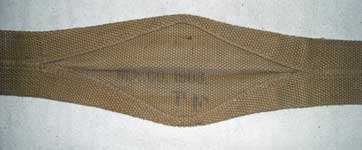 This detail of the inside center of a first issue Brace shows how it is made. Each Brace is actually a flattened tube of thin, single weave webbing. For about 18-inches in the center, the seam is left unwoven. The edges are then stretched apart at the center and sewn to make a lozenge shaped area tapering up to 3-inches wide. I assume that there must have been sizing of some sort that was supposed to keep the center section flat. What actually happened, of course, is exactly what one would expect. The load is in tension, which pulls the ends of the center section apart and the widened area folds up like an accordion. This is, I'm afraid, a perfect example of a design which is just too clever to actually work in the real world. The Mills Company was not long in correcting this design error.
This detail of the inside center of a first issue Brace shows how it is made. Each Brace is actually a flattened tube of thin, single weave webbing. For about 18-inches in the center, the seam is left unwoven. The edges are then stretched apart at the center and sewn to make a lozenge shaped area tapering up to 3-inches wide. I assume that there must have been sizing of some sort that was supposed to keep the center section flat. What actually happened, of course, is exactly what one would expect. The load is in tension, which pulls the ends of the center section apart and the widened area folds up like an accordion. This is, I'm afraid, a perfect example of a design which is just too clever to actually work in the real world. The Mills Company was not long in correcting this design error.

 The second issue Braces were introduced by List of Changes entry L. of C. No. 15048, dated 22nd November 1909. This L. of C. entry
made a number of changes to W.E. Patt. '08. Among them were changes to the Braces. The new issue were straps of plain, heavy webbing, 50-inches long and 2-inches wide. They were tipped with sturdy eyeletted brass tips. There would be no further changes to the Braces throughout their service life. This pair is maker marked "M.E. Co." and dated 1919.
The second issue Braces were introduced by List of Changes entry L. of C. No. 15048, dated 22nd November 1909. This L. of C. entry
made a number of changes to W.E. Patt. '08. Among them were changes to the Braces. The new issue were straps of plain, heavy webbing, 50-inches long and 2-inches wide. They were tipped with sturdy eyeletted brass tips. There would be no further changes to the Braces throughout their service life. This pair is maker marked "M.E. Co." and dated 1919.
Braces - Production Variations
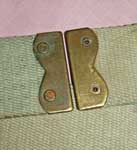
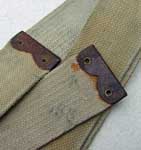 Pattern 1908 Braces were made for many years, by many different makers. Because they were simple straps, their manufacture did not require the special Mills looms needs for the more complicated pieces. Not surprisingly, variations are sometimes encountered, usually to simplify production or, in time of war, to preserve vital materials. During the Great War, simple pieces like these were often made by war-time emergency manufacturers. Here are two such variations. Far left, here the usual shell rivets have been replaced with solid ones. It's not clear whether this Brace has been neatly repaired with non-standard rivets, or if it was made this way. The rivets are the same on both ends of the Brace, by the way, one has just been turned over to show both sides. It's worth noting that the shape of the scallops in the Tips, brass is not quite the right shape for a product made by M.E. Co. or M.W. &. S., which supports the idea that it was made by another firm. Near left, another pair of Braces, this time with steel tips. We have seen WWI era equipment with steel tips before, private purchase items such as Officer's Rucksacks, so why not on Patt. '08? From the Martin Clewlow Collection, photographs © Martin Clewlow 2011.
Pattern 1908 Braces were made for many years, by many different makers. Because they were simple straps, their manufacture did not require the special Mills looms needs for the more complicated pieces. Not surprisingly, variations are sometimes encountered, usually to simplify production or, in time of war, to preserve vital materials. During the Great War, simple pieces like these were often made by war-time emergency manufacturers. Here are two such variations. Far left, here the usual shell rivets have been replaced with solid ones. It's not clear whether this Brace has been neatly repaired with non-standard rivets, or if it was made this way. The rivets are the same on both ends of the Brace, by the way, one has just been turned over to show both sides. It's worth noting that the shape of the scallops in the Tips, brass is not quite the right shape for a product made by M.E. Co. or M.W. &. S., which supports the idea that it was made by another firm. Near left, another pair of Braces, this time with steel tips. We have seen WWI era equipment with steel tips before, private purchase items such as Officer's Rucksacks, so why not on Patt. '08? From the Martin Clewlow Collection, photographs © Martin Clewlow 2011.

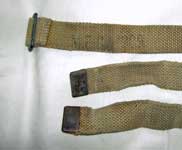 Supporting straps were introduced as part of Web Equipment, Pattern 1908 in List of Changes entry L. of C. No. 14288, dated 31st January 1908. Each Supporting strap was 32-inches long and 1-inch wide. The first issue Supporting straps had Twigg buckles on one end and plain brass tips on the other. This first issue pair is maker marked "M.E. Co." and dated 1909. From the Chris Pollendine Collection, photos © Chris Pollendine 2009.
Supporting straps were introduced as part of Web Equipment, Pattern 1908 in List of Changes entry L. of C. No. 14288, dated 31st January 1908. Each Supporting strap was 32-inches long and 1-inch wide. The first issue Supporting straps had Twigg buckles on one end and plain brass tips on the other. This first issue pair is maker marked "M.E. Co." and dated 1909. From the Chris Pollendine Collection, photos © Chris Pollendine 2009.
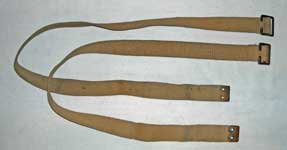 The plain brass tips were replaced by eyeletted ones with List of Changes entry L. of C. No. 15048, dated 22nd November 1909. There would be no further changes to the Supporting straps throughout their service life. This pair is maker marked "M.E. Co." and dated 1912.
The plain brass tips were replaced by eyeletted ones with List of Changes entry L. of C. No. 15048, dated 22nd November 1909. There would be no further changes to the Supporting straps throughout their service life. This pair is maker marked "M.E. Co." and dated 1912.

 Brace attachments were introduced by List of Changes entry L. of C. No. 16513, dated 5th March 1913, and amended 11th July 1913. They replace the Cartridge carriers when used by troops who do not carry a rifle. Originally authorised for Pipers and Range-takers, their use was later extended to machine gun crews, tank crews, OR's in the RFC, and others. They form part of the Pattern 1908 Pistol Equipment. This pair is maker marked "H.G.R. Ld." (Hepburn, Gale, & Ross, Ltd.) and dated 1918.
Brace attachments were introduced by List of Changes entry L. of C. No. 16513, dated 5th March 1913, and amended 11th July 1913. They replace the Cartridge carriers when used by troops who do not carry a rifle. Originally authorised for Pipers and Range-takers, their use was later extended to machine gun crews, tank crews, OR's in the RFC, and others. They form part of the Pattern 1908 Pistol Equipment. This pair is maker marked "H.G.R. Ld." (Hepburn, Gale, & Ross, Ltd.) and dated 1918.
A detail of the bodies of the Brace attachments, showing their construction. In use, the Brace connects to the buckle at the top, then passes through the loop in the center of the Brace adapter so that it can fall behind the Belt, which attaches to the vertical open bar buckle on the bottom of the Brace attachment.

